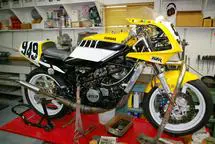
Crankshafts
Below is only a small part of the overall knowledge and documentation of crankshaft related subjects.
Crankshafts are a very complex subject. I will go over most of the basic information and slowly add links and data to show the overall workings of a 2 stroke crankshaft.
CRANKSHAFT FAILURE:
TDR has seen thousands of crank failures over the years. Every different type of failure has a specific sign as to what happened. If you have multiple failures and the same type of failed parts something is causing the same issue and has been missed. In diagnosing a crankshaft failure, I look at the evidence, (what has failed), and work backwards to find the problem. TDR started rebuilding crankshafts in 1973 and to this day have rebuilt close to 50,000 crankshafts. Mostly 2 strokes and a very small amount of 4 stroke crankshafts.
Right crank bearing outer race failure:
The cases are matched sets and CAN NOT BE MIXED. They are line bored from the factory. If you mix crankcases, you will have bearing failure.
Bearing clearance is by spec clearance scale. If the crankcase area where the bearing ride is out of round by even a few 10,000 of an inch it will put pressure on the outer race and this pressure will create friction in the ball or roller area. This friction will create heat that will further close the clearance resulting in catastrophic bearing failure shown in some of the previous pictures. Once a bearing fails or spins in the race the crankcase race is out of spec and cases are now trashed.
Crank Separation:
Crank web separation has a few different causes. First, pin to web clearance is critical. The interference fit or press fit needs to be within spec. If it is excessive or too tight the web will crack, and the material will become distorted or out of round. This results in never being able to true correctly. If it is too loose it will separate. It is up to the crankshaft assembler to be aware of the amount of pressure being applied on assembly. Once a crankshaft has been assembled with the correct pressure and it separates there as other reasons for that failure.
Over-rev:
Over-revving is another reason for crank separation. An engine makes horsepower at a specific RPM peak and looses horsepower beyond that. A CPI exhaust has a power peak at 9800 rpm. We have installed data acquisition on many motors. Ones that are prone to crankshaft failure are ones that are continually over-revved. Over-revving creates a harmonic vibration that shows up in different ways. One is crank separation, crankcase bearing surface chattering marks, flywheel separation, lower rod bearing cage failure. Over-revving cases a large percent of the failures followed by improper installation or not being aware of any crankcase imperfections.
Improper Clutch use and Setup:
Also keep in mind you are revving the engine at the start and dropping the clutch. The tires try to stop the engine or crankshaft rotation on the right side while the heavy flywheel is still moving on the left side. Crankshaft twist applies here. Also press fit also applies in this case. The looser the press fit the faster the crank will twist. This twisting creates pressure again on the bearing race and creates heat and eventually failure.
Detonation:
Detonation is the silent evil that will destroy crankshafts slowly and mysteriously. Detonation has many causes and is complex to identify. I will add to this section later.
There are 2 different lower rod bearing cage styles used in most of the Banshee cranks. The more expensive cranks use the better bearing. Over-revving will cause the lower cage to break apart and the small pieces will be evident in the top of the pistons. The small pieces will contact the rollers and make them skid causing lower rod meltdown. Out of balance flywheel and welding of the flywheel onto the crank web. If a flywheel is pried on to remove it the flywheel shell will be out of alignment with the inner solid support. The only way to remove a flywheel is to use the correct puller that pulls directly in the center. Any prying or tapping on the outer shell will cause damage. This misalignment will again cause a vibration and make the crankshaft separate and chatter.
Misaligned flywheel key:
When installing a flywheel key you must make sure it is seated correctly or the flywheel will be off-center and cause the same separation and vibration. Offset keyways are especially prone to this. I do prefer a good adjustable timing plate.
OIL:
Outboard motor oil is not a high-performance oil. Not that you have taken your 33 horsepower from the factory Banshee motor and are producing more that 100 hp the same oil does not sufficiently lubricate the critical parts. Especially if you are using alcohol. Alcohol is a solvent. Solvents dissolve and wash down oil from the moving parts. Special oils are required for alcohol engines. If this oil is not used the crankshaft moving parts will fail quickly. Lack of lubrication is evident when the disassembled parts are inspected for excessive wear or general meltdown of the lower rod parts.
And I can keep going. The crankshaft leads a very hard life and needs proper assembly and proper oil to run a long time. Even if installed perfect with all new parts, over-revving and rider mis-use will destroy it in only a few runs. Just because a crankshaft fails it is not necessarily the crankshafts fault. All 3 components combined, proper build, proper oil, and proper rider input, will result in a long running motor. If this is not your case carefully read the above.
